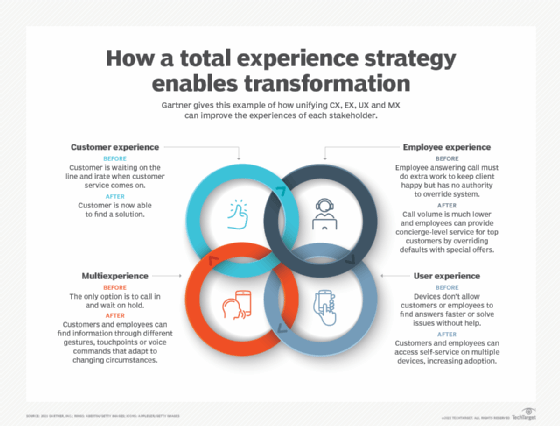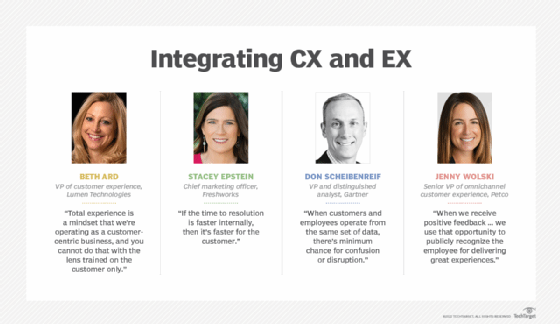Why you need a total experience strategy to drive CX and EX
More companies are using a 'total experience' approach to win customers and support employees in the post-pandemic economy. But they won't find a single platform that does it all.
For Lumen Technologies, a provider of cloud, security and networking services, creating and delivering an exemplary customer experience has long been the secret sauce to differentiating itself in a competitive market. Yet, while Lumen was hitting all the right notes -- doing sentiment analysis, mapping the customer journey and embracing a centralized platform to keep track of customer needs and expectations -- the company soon realized it lacked a key element in its carefully-crafted CX plan: factoring employee experience (EX) into the total experience mix.
"The employee experience is critical to delivering a positive customer experience, and we have data that correlates to that," said Beth Ard, Lumen's vice president of customer experience. "If an install wasn't on time or there was some other problem, it was typically related to some obstacle in an employee's workflow, in our processes or the technology keeping employees from delivering a good customer experience. It's one big story."
Lumen, like so many other companies heading down the CX management track, has determined that delivering a compelling and well-orchestrated customer experience is directly intertwined with how well employees are empowered to do their work and respond to customer needs while also feeling fulfilled by their job.
With the pace of digital transformation accelerating, in part due to changes brought on by the ongoing pandemic, companies' primary objectives are to enhance customer experiences (58%) and improve employee productivity (57%), according to Gartner's "2021 Digital Business Acceleration Survey." Yet, rather than pursue one or the other as siloed initiatives, companies are beginning to recognize that a holistic experience strategy has far greater potential for advancing better business outcomes.
What's emerging is what Gartner calls total experience, a strategy that connects CX, EX, user experience (UX) and multiexperience (MX) technologies that span myriad touchpoints and devices. The idea is that interlinking the four disciplines in a comprehensive business strategy provides exponential value compared to addressing each individually in a vacuum, since the experiences impact and influence each other (see graphic below). By thinking about and enabling experiences holistically, organizations have a much better chance to move the needle on the business outcomes they desire, whether that's enhancing customer satisfaction, creating a healthy and productive work environment, improving product and service quality or increasing brand loyalty.
In fact, Gartner estimated that by 2024 organizations providing a total experience will outperform competitors by 25% in satisfaction metrics for both CX and EX. By 2026, the firm expects 60% of large enterprises to employ a total experience strategy to transform their business models and achieve "world-class customer and employee advocacy levels" in which both groups are motivated to promote the corporate brand.

Pandemic made experience management top priority
While elevating customer experience has been in the works at companies for some time, the focus on total experience management from both a customer and employee perspective is relatively new, amplified these past couple of years by pandemic-sparked market shifts and employment trends. It's been well documented that consumers have a desire for more personalized and streamlined digital interactions like they experience with Amazon and Netflix for everything from common retail and hospitality experiences to engagement with healthcare and other service providers.
It follows that employees -- accustomed to these digital experiences in their everyday lives -- also have heightened expectations for similar frictionless engagement with the people and systems that are essential to their day-to-day routines and crucial to their ability to deliver for customers and, ultimately, the business. Pandemic-induced changes have led to a massive recalibration of the workforce, escalating the war for talent and putting pressure on companies to provide tools to make work more productive and enable greater work/life balance. According to Gartner's "2021 Digital Worker Experience Survey," 79% of respondents said digital technology is essential to getting their jobs done.
 Adrian McDermott
Adrian McDermott
"We're living in a moment in which the power dynamic between employer and employees is shifting in the digital economy," said Adrian McDermott, CTO of Zendesk Inc., which makes an online customer service platform. "With an increasingly mobile and remote workforce, we're trying to learn how to replace in-person rituals and moments with digital ones to build employee community and generate a sense of employee loyalty. That's what most businesses are struggling with."
Organizations are also struggling to make good on their customer experience agendas to differentiate themselves and create an advantage during a period of intense competition and upheaval as products and services become commoditized, new competitors spring to market at lightning speed and the COVID-19 crisis continues to disrupt operations.
In a report analyzing Zendesk product usage data and surveys of consumers and customer service workers, the vendor found connections between customer agent empowerment and customer satisfaction ratings. Nearly half of those consumers surveyed said helpful and empathetic agents are what matter most during a customer service issue, but more than 68% of respondents felt agents need more training. For their part, only a fifth of agents surveyed felt the quality of training was sufficient for delivering positive experiences, 82% of support teams felt overwhelmed, and turnover has become a big problem and a potential roadblock for CX success.
"Total experience is a mindset that we're operating as a customer-centric business, and you cannot do that with the lens trained on the customer only," Lumen's Ard contended. "It has to be on the whole experience, from the employee to the customer to the digital interactions we have with customers. Brand relationships and product experience are also part of that." To measure and understand the full 360-degree view, Lumen is using the Qualtrics platform, Ard said.
What total experience looks like
Total experience should be approached as a business strategy that drives supportive, shared experiences between customers and employees as opposed to being about any specific product or platform, according to Don Scheibenreif, vice president and distinguished analyst in Gartner's customer experience group. Rather than merging all experiences into one "uber" function, Scheibenreif said the idea is to preserve what makes each experience different while at the same time making collaboration and working across functions more deliberate.
So, what exactly would that look like in practice? In its "2022 Top Strategic Technology Trends" report, Gartner highlighted a total experience use case from Fidelity Investments. Fidelity Spire, a free financial services app, employs analytics and AI to learn client behavior, which helps staffers respond proactively to a client's next action. It also serves up insights that inform realistic training simulations to improve staffers' ability to provide service -- an example of how EX (in this case, training) can improve CX. At the same time, the Spire app draws on unified identity services to allow Fidelity clients to move easily through self-service onboarding while providing integration to the financial advisor's view across multiple touchpoints -- an example of CX, EX, MX and UX all coming together.
 Ben Granger
Ben Granger
Disney is another company running on all experience cylinders, combining apps, RFID-enabled wristbands and myriad enterprise technologies. The result is a frictionless experience for consumers, allowing them to manage itineraries, make dinner reservations, take advantage of FastPass rides and pay for souvenirs and park dining. At the same time, the capabilities underpin an employee experience that enables hotel front desk personnel to track arriving guests so they can anticipate and correct travel bottlenecks while providing higher levels of service to concierge guests. The EX extends to restaurant hosts in the Disney parks, helping them keep tabs on reservation holders to ensure timely seating and avoid revenue loss from no-shows. While the latter capabilities might seem more oriented toward CX, Gartner considers them an EX function because they provide employees with the tools to do their jobs better.
Or, consider total experience through the lens of a major hotel chain. With a well-crafted total experience strategy supported by mobile apps and digital services, guests can easily take care of routine tasks such as check-in and checkout, order services and turn devices on and off in the room. At the same time, hotel personnel can communicate with guests through the same app, which helps reduce friction in the customer experience -- for example, allowing them to replace lost receipts and making guests aware that a door battery is running low to avoid frustration and inconvenience.
As these scenarios illustrate, bringing employee and customer experience together allows organizations to understand the impact each has on the other. But it's also about uncovering specific actions and changes that can be implemented. One example of this is improving training for employees so they sustain exceptional customer service and ultimately influence customer attitudes and behaviors, such as repurchases and referrals, said Ben Granger, head of EX advisory services at Qualtrics, an experience management software vendor. Call centers are evaluated on a combination of KPIs based on operational metrics such as average handle time, first call resolution or occupancy rate, as well as customer experience metrics -- for example, overall customer satisfaction and representative effectiveness. A survey of call center employees will often reveal an issue much more efficiently than programs that only look at customer data.
"A business may find that agents feel the need to rush resolutions because of a new target for handle time, and they can see a correlated spike in customers saying they are feeling rushed on calls," Granger said. "A combined CX/EX approach allows leaders to have more insight to help diagnose and fix the problem."
Strategies and implementation practices will vary from organization to organization; some will seek out a common platform, while others integrate specialized capabilities into a hybrid system. Yet, the benefits and goals of a total experience strategy remain pretty consistent across the board.
"When customers and employees operate from the same set of data, there's minimum chance for confusion or disruption," said Gartner's Scheibenreif.

Total experience technologies run the gamut
The buzz around total experience may be growing, but the product category is still relatively immature and it can be confusing to sort through all the different players. While the business strategy is becoming clearer, the platforms positioned to deliver on total experience come from different corners of the software market. Most currently address some portion of what's required and are building out functionality or aligning with partners to create an integrated and more holistic platform.
 Ray Wang
Ray Wang
Experience management vendors like Qualtrics and Medallia Inc. are at one end of the spectrum, while tools like Alida are building off of customer feedback and sentiment analysis capabilities to meet total experience needs.
ServiceNow and Zendesk, which started as help desk and workflow platforms, have aggressively steered toward experience management and now total experience, while companies such as Freshworks Inc. are taking aim at CX and EX by emphasizing accessibility and simplicity through SaaS and low-code development capabilities. Companies in the unified communications as a service (UCaaS) space are also pitching their tent in the total experience arena, as communication is the backbone of any experience scenario.
The different offerings solve for different parts of total experience, and there isn't yet one platform that covers the entire spectrum of capabilities required for an end-to-end strategy. Some products are better at journey mapping, sentiment and behavioral analysis, and feedback management while others excel at workflow, knowledge management and ticket management. Most prioritize communications capabilities such as live chat, social and AI-powered bots while emphasizing their ability to manage experience data and respond to customers or employees from one unified space.
Because most data and processes related to engagement with customers or employees are currently orchestrated by multiple and oftentimes traditional systems such as HR, customer relationship management or e-commerce, it's difficult to execute on total experience.
"These journeys are really processes, and the processes have to be brought together and potentially put on the same platform," said R "Ray" Wang, principal analyst and founder of Constellation Research Inc. "The onboarding journey has to be tied to the recruiting journey, tied to employee benefits and tied to the customer service system to create these experiences. The platforms don't exist right now, but that's what people want to build."
Whichever the route, a buildable platform for total experience has to incorporate a number of capabilities to ensure scalability. Support for APIs and microservices is critically important to address integration, connect workflows across platforms and tap into data in large-scale enterprise systems like ERP. Flexibility and easy customization are other key attributes.
"Companies need to consider how open a technology is to ingesting data and pushing data out when you're looking at total experience and you're talking about lots of potential sources of data," said Qualtrics' Granger.
 Riaz Raihan
Riaz Raihan
Qualtrics has created integrations with other providers, including ServiceNow, to extend its platform's capabilities. The Qualtrics integration lets users build automated ServiceNow customer and employee service workflows using Qualtrics voice of the customer data, while data visualization tools in ServiceNow can now put Qualtrics sentiment data on users' dashboards.
"We all live in complicated ecosystems in terms of the proliferation of systems within the organization," said Zendesk's McDermott. "Companies need to look for solutions that are as comfortable behind the firewall with integration as they are with B2C or B2B integrations."
Rather than build out a total experience platform and workflow through integration, Petco is tackling CX and EX with the Medallia platform. From a data and analytics perspective, hosting the data in one location enables the extended team to mine it more effectively and efficiently and allows for a firm connection between employee and customer experience, according to Jenny Wolski, Petco's senior vice president of omnichannel customer experience. From a user experience standpoint, allowing all employees to use the same platform for the same purpose creates a unified approach to feedback and other actions, she said.
Petco uses the feedback and data from the system to provide better experiences for both employees and customers, but it's the interconnected nature of the two experiences working together that makes the most difference.
"When we receive positive feedback from several customers about a specific employee in one of Petco's stores, we use that opportunity to publicly recognize the employee for delivering great experiences," she said. "That employee feels valued and appreciated for their hard work and commitment."
 Dave Wright
Dave Wright
MultiChoice Group, an African broadcasting and pay television company, has also gravitated to a single platform as it builds out its CX/EX workflows. Using Freshworks' Freshservice and Freshdesk tools, the company is aiming for faster omnichannel customer support across its IT and support teams for South African customers. The customer engagement piece builds unified customer records across all communication channels. The Freshdesk component brings together disparate customer touchpoints, including walk-ins, calls, chat, email and social media so they are visible in a single help desk system and connected by the customer thread.
By using both platforms for an interconnected experience for subscribers and customer support agents, the agents are able to quickly escalate customer queries that require cross-team support without having to toggle between two systems.
"Being on the same platform with a common user experience means that questions or issues are resolved faster," said Stacey Epstein, Freshworks' chief marketing officer. "If the time-to-resolution is faster internally, then it's faster for the customer. You don't want an employee sitting around waiting for the help they need for days."
Challenges and best practices
As companies dive into total experience, there are a number of steps they should take to ensure the initiative stays on track and, more importantly, delivers for the business. Among the key considerations suggested by experience management experts and practitioners are the following:
- Map the customer and employee journeys separately. Even before any technology decisions, organizations should engage business and IT leaders to map out the customer and employee journeys as well as identifying critical intersections and areas of improvement. "The last thing you want to do is replicate a crappy experience to the digital world," said Constellation Research's Wang. "You have to manually figure out what the right process is and figure out where to automate or insert a human."
 Elena Hutchison
Elena Hutchison
- Create cross-functional teams. Gartner recommends engaging CX, EX, UX and MX leaders or corresponding centers of excellence to form a total experience "fusion team" that crosses activity silos. These teams should help rally support around initiatives by showcasing how total experience activities can drive greater revenue growth or new customer opportunities. They should also focus on how a total experience strategy can transform roles and make the organization more agile, Scheibenreif said. There should be a governance process that allows leaders and teams from the different experience programs to collaborate on shared objectives and practices.
- Define a system of record. One of the biggest challenges of total experience is that it involves multiple systems, often with different UI designs and data repositories. Companies need to determine how they want their holistic experience to appear and where automation can come into play. Data management is another big challenge. "Companies end up building complex systems that replicate data across multiple systems when, in most cases, they don't need all of the data -- just some part to give people the experience they need," said Dave Wright, chief innovation officer at ServiceNow.
- Ensure closed-loop practices. Integration with critical systems is important for a number of reasons, including to create closed-loop workflows that initiate some form of action in response to customer or employee feedback. "Asking for feedback is not enough," said Riaz Raihan, president of products and engineering at Alida. "If you don't act on it and you're just paying lip service, then you're better off not asking for feedback at all."
In the end, as with most complex technology-enabled endeavors, the real challenge to getting total experience right is not technical, but more about managing culture and orchestrating change.
"Where most programs fail is because the silos go all the way to the executive team and they're not on the same page," said Elena Hutchison, executive vice president for strategy and product marketing at Medallia. "Technology can help, but ultimately this is a change management and executive alignment exercise."







